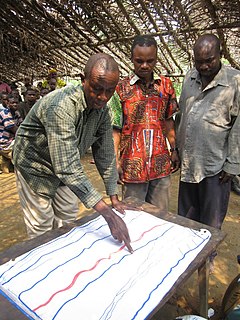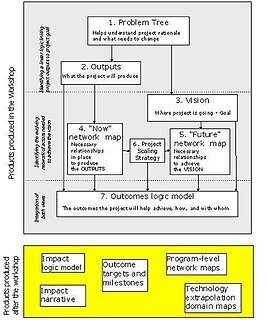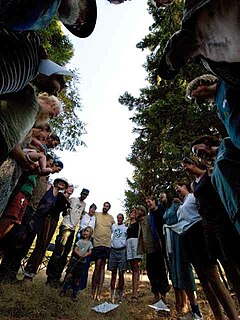Evaluation is a systematic determination and assessment of a subject's merit, worth and significance, using criteria governed by a set of standards. It can assist an organization, program, design, project or any other intervention or initiative to assess any aim, realisable concept/proposal, or any alternative, to help in decision-making; or to ascertain the degree of achievement or value in regard to the aim and objectives and results of any such action that has been completed. The primary purpose of evaluation, in addition to gaining insight into prior or existing initiatives, is to enable reflection and assist in the identification of future change. Evaluation is often used to characterize and appraise subjects of interest in a wide range of human enterprises, including the arts, criminal justice, foundations, non-profit organizations, government, health care, and other human services. It is long term and done at the end of a period of time.
Strategic planning is an organization's process of defining its strategy or direction, and making decisions on allocating its resources to attain strategic goals.
Development communication refers to the use of communication to facilitate social development. Development communication engages stakeholders and policy makers, establishes conducive environments, assesses risks and opportunities and promotes information exchange to create positive social change via sustainable development. Development communication techniques include information dissemination and education, behavior change, social marketing, social mobilization, media advocacy, communication for social change, and community participation.
Program evaluation is a systematic method for collecting, analyzing, and using information to answer questions about projects, policies and programs, particularly about their effectiveness and efficiency. In both the public and private sectors, stakeholders often want to know whether the programs they are funding, implementing, voting for, receiving or objecting to are producing the intended effect. While program evaluation first focuses around this definition, important considerations often include how much the program costs per participant, how the program could be improved, whether the program is worthwhile, whether there are better alternatives, if there are unintended outcomes, and whether the program goals are appropriate and useful. Evaluators help to answer these questions, but the best way to answer the questions is for the evaluation to be a joint project between evaluators and stakeholders.
Policy analysis is a technique used in public administration to enable civil servants, activists, and others to examine and evaluate the available options to implement the goals of laws and elected officials. The process is also used in the administration of large organizations with complex policies. It has been defined as the process of "determining which of various policies will achieve a given set of goals in light of the relations between the policies and the goals."
Participatory design is an approach to design attempting to actively involve all stakeholders in the design process to help ensure the result meets their needs and is usable. Participatory design is an approach which is focused on processes and procedures of design and is not a design style. The term is used in a variety of fields e.g. software design, urban design, architecture, landscape architecture, product design, sustainability, graphic design, planning, and even medicine as a way of creating environments that are more responsive and appropriate to their inhabitants' and users' cultural, emotional, spiritual and practical needs. It is also one approach to placemaking.
Poverty Reduction Strategy Papers (PRSPs) are documents required by the International Monetary Fund (IMF) and World Bank before a country can be considered for debt relief within the Heavily Indebted Poor Countries (HIPC) initiative. PRSPs are also required before low-income countries can receive aid from most major donors and lenders. The IMF specifies that the PRSP should be formulated according to five core principles. The PRSP should be country-driven, result-oriented, comprehensive, partnership-oriented, and based on a long-term perspective. The PRS process encourages countries to develop a more poverty-focused government and to own their own strategies through developing the plan in close consultation with the population. A comprehensive poverty analysis and wide-ranging participation are vital parts of the PRSP formulation process. There are many challenges to PRS effectiveness, such as state capacity to carry out the established strategy. Criticism of PRSP include aid conditionality, donor influence, and poor fulfillment of the participatory aspect.
Public participation, also known as citizen participation or patient and public involvement, is the inclusion of the public in the activities of any organization or project. Public participation is similar to but more inclusive than stakeholder engagement.
Strategic communication can mean either communicating a concept, a process, or data that satisfies a long-term strategic goal of an organization by allowing facilitation of advanced planning, or communicating over long distances usually using international telecommunications or dedicated global network assets to coordinate actions and activities of operationally significant commercial, non-commercial and military business or combat and logistic subunits. It can also mean the related function within an organization, which handles internal and external communication processes. Strategic communication can also be used for political warfare.

Participatory planning is an urban planning paradigm that emphasizes involving the entire community in the community planning process. Participatory planning emerged in response to the centralized and rationalistic approaches that defined early urban planning work. It has become a highly influential paradigm both in the context of traditional urban planning, and in the context of international community development. There is no singular theoretical framework or set of practical methods that make up participatory planning. Rather, it is a broad paradigm which incorporates a wide range of diverse theories and approaches to community planning. In general, participatory planning programs prioritize the integration of technical expertise with the preferences and knowledge of community members in the planning process. They also generally emphasize consensus building and collective community decision making, and prioritize the participation of traditionally marginalized groups in the planning process.

Participatory impact pathways analysis (PIPA) is a project management approach in which the participants in a project, including project staff, key stakeholders, and the ultimate beneficiaries, together co-construct their program theory.
Interactive planning is a concept developed by Russell L. Ackoff, an American theorist, early proponent of the field of operations research and recognized as the pioneer in systems thinking. Interactive planning forwards the idea that in order to arrive at a desirable future, one has to create a desirable present and create ways and means to resemble it. One of its unique features is that development should be ideal-oriented. Interactive planning is unlike other types of planning such as reactive planning, inactive planning, and preactive planning.

Participatory development (PD) seeks to engage local populations in development projects. Participatory development has taken a variety of forms since it emerged in the 1970s, when it was introduced as an important part of the "basic needs approach" to development. Most manifestations of public participation in development seek "to give the poor a part in initiatives designed for their benefit" in the hopes that development projects will be more sustainable and successful if local populations are engaged in the development process. PD has become an increasingly accepted method of development practice and is employed by a variety of organizations. It is often presented as an alternative to mainstream "top-down" development. There is some question about the proper definition of PD as it varies depending on the perspective applied. Two perspectives that can define PD are the "Social Movement Perspective" and the "Institutional Perspective":

A working group, or working party, is a group of experts working together to achieve specified goals. The groups are domain-specific and focus on discussion or activity around a specific subject area. The term can sometimes refer to an interdisciplinary collaboration of researchers working on new activities that would be difficult to sustain under traditional funding mechanisms.

Social and behavior change communication (SBCC), often also only "BCC" or "Communication for Development (C4D)" is an interactive process of any intervention with individuals, group or community to develop communication strategies to promote positive behaviors which are appropriate to their settings and thereby solving the world's most pressing health problems. This in turn provides a supportive environment which will enable people to initiate, sustain and maintain positive and desirable behavior outcomes.

Community mobilization is an attempt to bring both human and non-human resources together to undertake developmental activities in order to achieve sustainable development.
Recreation resource planning is a rational systematic decision-making process about the future management of recreation resources and recreation opportunities. Recreation planning applies analytical tools to deter our human tendencies to make decisions based on predisposition, bias, inadequate analysis, group-think, insular perspective, resistance to change, and excessive self-confidence. It results in decisions that are more effective, efficient, fair, reasoned, and defensible.

Theory of Change (ToC) is a methodology for planning, participation, adaptive management, and evaluation that is used in companies, philanthropy, not-for-profit, international development, research, and government sectors to promote social change. Theory of Change defines long-term goals and then maps backward to identify necessary preconditions.
The PRECEDE–PROCEED model is a cost–benefit evaluation framework proposed in 1974 by Lawrence W. Green that can help health program planners, policy makers and other evaluators, analyze situations and design health programs efficiently. It provides a comprehensive structure for assessing health and quality of life needs, and for designing, implementing and evaluating health promotion and other public health programs to meet those needs. One purpose and guiding principle of the PRECEDE–PROCEED model is to direct initial attention to outcomes, rather than inputs. It guides planners through a process that starts with desired outcomes and then works backwards in the causal chain to identify a mix of strategies for achieving those objectives. A fundamental assumption of the model is the active participation of its intended audience — that is, that the participants ("consumers") will take an active part in defining their own problems, establishing their goals and developing their solutions.
Participatory evaluation is an approach to program evaluation. It provides for the active involvement of stakeholder in the program: providers, partners, beneficiaries, and any other interested parties. All involved decide how to frame the questions used to evaluate the program, and all decide how to measure outcomes and impact. It is often used in international development.






